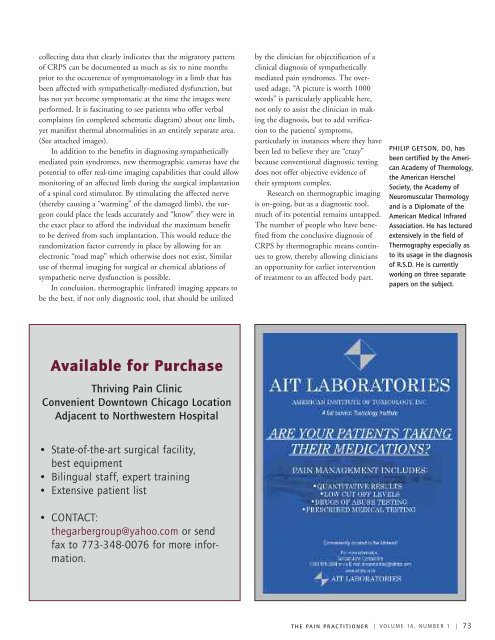printer-friendly version (PDF) - Reflex Sympathetic Dystrophy ...
printer-friendly version (PDF) - Reflex Sympathetic Dystrophy ...
printer-friendly version (PDF) - Reflex Sympathetic Dystrophy ...
You also want an ePaper? Increase the reach of your titles
YUMPU automatically turns print PDFs into web optimized ePapers that Google loves.
collecting data that clearly indicates that the migratory pattern<br />
of CRPS can be documented as much as six to nine months<br />
prior to the occurrence of symptomatology in a limb that has<br />
been affected with sympathetically-mediated dysfunction, but<br />
has not yet become symptomatic at the time the images were<br />
performed. It is fascinating to see patients who offer verbal<br />
complaints (in completed schematic diagram) about one limb,<br />
yet manifest thermal abnormalities in an entirely separate area.<br />
(See attached images).<br />
In addition to the benefits in diagnosing sympathetically<br />
mediated pain syndromes, new thermographic cameras have the<br />
potential to offer real-time imaging capabilities that could allow<br />
monitoring of an affected limb during the surgical implantation<br />
of a spinal cord stimulator. By stimulating the affected nerve<br />
(thereby causing a “warming” of the damaged limb), the surgeon<br />
could place the leads accurately and “know” they were in<br />
the exact place to afford the individual the maximum benefit<br />
to be derived from such implantation. This would reduce the<br />
randomization factor currently in place by allowing for an<br />
electronic “road map” which otherwise does not exist. Similar<br />
use of thermal imaging for surgical or chemical ablations of<br />
sympathetic nerve dysfunction is possible.<br />
In conclusion, thermographic (infrared) imaging appears to<br />
be the best, if not only diagnostic tool, that should be utilized<br />
by the clinician for objectification of a<br />
clinical diagnosis of sympathetically<br />
mediated pain syndromes. The overused<br />
adage, “A picture is worth 1000<br />
words” is particularly applicable here,<br />
not only to assist the clinician in making<br />
the diagnosis, but to add verification<br />
to the patients’ symptoms,<br />
particularly in instances where they have<br />
been led to believe they are “crazy”<br />
because conventional diagnostic testing<br />
does not offer objective evidence of<br />
their symptom complex.<br />
Research on thermographic imaging<br />
is on-going, but as a diagnostic tool,<br />
much of its potential remains untapped.<br />
The number of people who have benefited<br />
from the conclusive diagnosis of<br />
CRPS by thermographic means continues<br />
to grow, thereby allowing clinicians<br />
an opportunity for earlier intervention<br />
of treatment to an affected body part.<br />
PHILIP GETSON, DO, has<br />
been certified by the American<br />
Academy of Thermology,<br />
the American Herschel<br />
Society, the Academy of<br />
Neuromuscular Thermology<br />
and is a Diplomate of the<br />
American Medical Infrared<br />
Association. He has lectured<br />
extensively in the field of<br />
Thermography especially as<br />
to its usage in the diagnosis<br />
of R.S.D. He is currently<br />
working on three separate<br />
papers on the subject.<br />
Available for Purchase<br />
Thriving Pain Clinic<br />
Convenient Downtown Chicago Location<br />
Adjacent to Northwestern Hospital<br />
State-of-the-art surgical facility,<br />
best equipment<br />
Bilingual staff, expert training<br />
Extensive patient list<br />
•<br />
•<br />
•<br />
• CONTACT:<br />
thegarbergroup@yahoo.com or send<br />
fax to 773-348-0076 for more information.<br />
T H E PA I N P R A C T I T I O N E R | V O L U M E 16 , N U M B E R 1 | 73
















